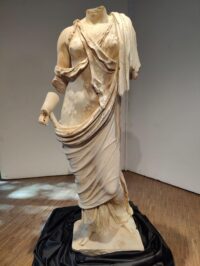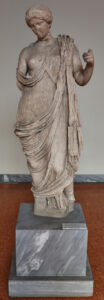 Archaeologists from the Spanish School of History and Archaeology of Rome (EEHAR) have unearthed an exceptional marble statue of a female figure at the ancient city of Tusculum 15 miles outside Rome. The statue is life-sized, and is missing its head and some of its arms, but the flawless white Parian marble and the quality of the carving are extraordinary.
Archaeologists from the Spanish School of History and Archaeology of Rome (EEHAR) have unearthed an exceptional marble statue of a female figure at the ancient city of Tusculum 15 miles outside Rome. The statue is life-sized, and is missing its head and some of its arms, but the flawless white Parian marble and the quality of the carving are extraordinary.
The missing parts makes it difficult to identify, but the upper body is draped in a fawn skin, an attribute of followers of Dionysus. This depiction is typically dated to between the mid-1st century B.C. and the mid-1st century A.D. The statue was carved in the round and fine details of the draping, the wet fabric of the chiton clinging to her skin, the workmanship of the fawn skin are superior, comparable to some of the greatest works of antiquity like the Aphrodite Areia found in Epidaurus and now in the National Archaeological Museum of Athens.
Tusculum was an ancient Latin city in the Alban Hills. Its legendary history attributes its founding to mythological Greek heroes (Telegonus, son of Odysseus and Circe) or their descendants (Latinus Silvius, the fourth great-grandson of Aeneas), but the earliest archaeological evidence suggests it had an established population by the 8th or 7th century B.C. The monumental city walls date to the 5th and 4th centuries B.C., the same period when Tusculum allied itself with Rome against its neighboring Latin tribes.
That alliance was cemented in 381 B.C. when Tusculum became the first municipium cum suffragio, a self-governing city whose citizens had the right to vote and hold public office in Rome. This category was reserved for cities whose populations at every social stratum (not just the governing elites), had demonstrated a strong desire to integrate with the Roman Republic.
 In the late Republic, Tusculum became a fashionable location for country villas. The most prominent and wealthy families in Rome built large homes there to flee the heat of the Eternal City in the summer. The remains of than 130 luxury villas and country estates have been documented even though most of the town has not been excavated. They came to dominate Tusculum so thoroughly that the city itself dimmed in importance and became little more than an adjunct to the summer homes of the wealthy. Cicero had a villa there, as did generations of Cato the Elder’s family and the imperial Flavii family.
In the late Republic, Tusculum became a fashionable location for country villas. The most prominent and wealthy families in Rome built large homes there to flee the heat of the Eternal City in the summer. The remains of than 130 luxury villas and country estates have been documented even though most of the town has not been excavated. They came to dominate Tusculum so thoroughly that the city itself dimmed in importance and became little more than an adjunct to the summer homes of the wealthy. Cicero had a villa there, as did generations of Cato the Elder’s family and the imperial Flavii family.
The statue dates to the period of Tusculum’s heyday as an enclave of Rome’s elite. It was unearthed in the last excavation campaign (October 2022-July 2023) in an area near the forum where a monumental baths complex was built in the Hadrianic period (117-138 A.D.). It was found face-down on a thin layer of painted stucco that originally adorned the walls of the thermal baths.
It was exhibited in public for the first time on Friday at the Aldobrandini Scuderie in Frascati. The exhibition ends Saturday, but it will undergo conservation in public view at the museum.
What an enthralling discovery! The unveiling of this exquisite marble statue from Tusculum provides a captivating glimpse into the opulence and artistic mastery of ancient times. Kudos to the archaeologists and researchers for their dedication in unearthing and preserving this invaluable piece of history. Thank you for sharing this remarkable discovery and providing such insightful context.